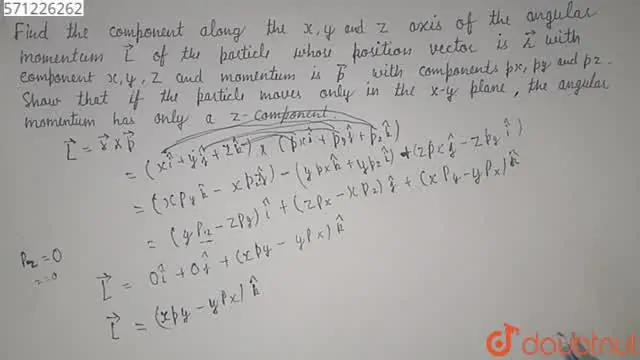A child stands at the centre of a turn table with his two arms outstretched. The turn table is set rotating with an angular speed of 40 rpm. How much is the angular speed of the child, if he folds his hands back reducing the moment of inertia to (2/5) time the initial value ? Assume that the turn table rotates without friction.
(b) Show that the child's new K.E. of rotation is more than the initial K.E. of rotation. How do you account for this increase in K.E. ?
(a) Suppose, initial moment of inertia of the child is l1 Then final moment of inertia,
I2=25Il
Also, v1=40rev−1min
By using the principle of conservation of angular momentum, we get
I1ω1=(I2ω2 or I1(2πv1)=I2(2πv2)
or v2=I1v1I2=I1×4025×I1=100rev min−1
(b) ("Final K.E. of rotation")/("Initial K.E. of rotation")=((1)/(2)I_(2)omega_(2)^(2))/((1)/(2)I_(1)omega_(1)^(2))=((1)/(2)I_(2)(2piv_(2))^(2))/((1)/(2)I_(1)(2pi v_(1))^(2))=(I_(2)v_(2)^(2))/(I_(1)v_(1)^(2))=((2)/(5)I_(1)xx(100)^(2))/((2)/(5)I_(1)xx(40)^(2))=2.5<br>C≤arly,f∈al(K.E.)_("not") becomes more because the child uses his internal energy when he folds his hands to increase the kinetic energy.
Related Playlists
- BOOK - NCERT ENGLISHCHAPTER - SYSTEMS OF PARTICLES AND ROTATIONAL MOTIONEXERCISE - EXERCISE33videos
SYSTEMS OF PARTICLES AND ROTATIONAL MOTION
- BOOK - NCERT ENGLISHCHAPTER - PHYSICAL WORLD EXERCISE - EXERCISE16videos
PHYSICAL WORLD
- BOOK - NCERT ENGLISHCHAPTER - THERMAL PROPERTIES OF MATTEREXERCISE - EXERCISE22videos
THERMAL PROPERTIES OF MATTER
Similar Questions
The angular speed of rotation of the earth is
View SolutionA child is standing with his two arms outstretched at the centre of a turntable that is rotating about its central axis with an angular speed ω0. Now, the child folds his hands back so that moment of inertia becomes 3 times the initial value. The new angular speed is.
View SolutionA man is sitting on a rotating stool with his arms outstretched. If suddenly he folds his arms the angular velocity of the man would
View SolutionA rotating wheel changes angular speed from 1800 rpm to 3000 rpm in 20 s. What is the angular acceleration assuming to be uniform?
View SolutionA rotating wheel changes angular speed from 1800 rpm to 3000 rpm in 20 s. What is the angular acceleration assuming to be uniform?
View SolutionA rotating wheel changes angular speed from 1800 rpm to 3000 rpm in 20 s. What is the angular acceleration assuming to be uniform?
View SolutionA diver having a moment of inertia of 6.0kg−m2 about an axis through its centre of mass rotates at an angular speed of 2 rad/s about this axis. If he folds his hands and feet to decrease the moment of inertia to 5.0 kg-m^2 what will be the new angular speed?
View SolutionA disc is rotating with angular velocity ω. If a child sits on it, what is conserved?
View SolutionA torque T acts on a body of moment of inertia l rotating with angular speed ω. It will be stopped just after time
View SolutionThe shaft of a motor rotates at a constant speed of 1800 rpm. What is the angle in radians it has turned through in one second ?
View Solution


